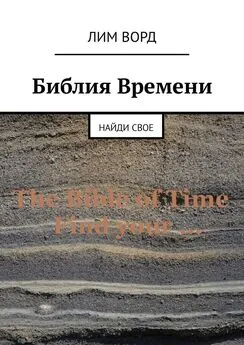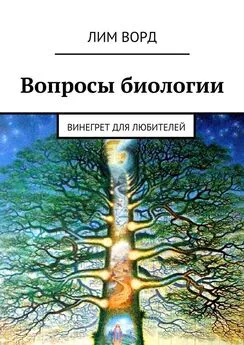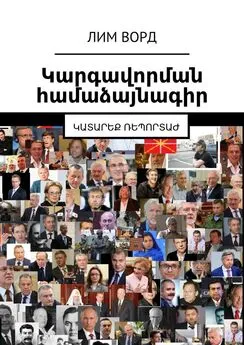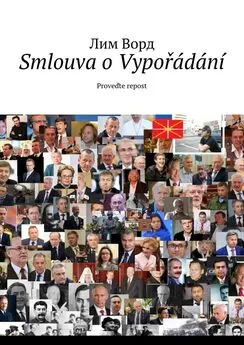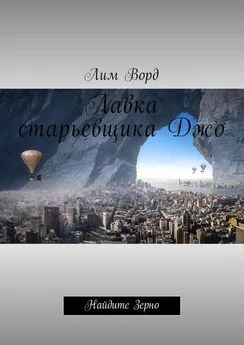Лим Ворд - Библия Времени. Найди свое
- Название:Библия Времени. Найди свое
- Автор:
- Жанр:
- Издательство:неизвестно
- Год:неизвестен
- ISBN:9785449318695
- Рейтинг:
- Избранное:Добавить в избранное
-
Отзывы:
-
Ваша оценка:
Лим Ворд - Библия Времени. Найди свое краткое содержание
Библия Времени. Найди свое - читать онлайн бесплатно ознакомительный отрывок
Интервал:
Закладка:
Each new governor justifies the new center of the capital, marking it with a huge five-tower temple, symbolizing the sacred Medu mountain Meru, the abode of Hindu gods, Eden, until finally the construction depletes all the tufa and sandstone in the country. In 1431, the Khmer State lost the war to neighboring Siam. Almost a million inhabitants of Angkor scatter in the jungle or, in a short time, die at the hands of enemy soldiers.
Angkor Wat – the palace and temple complex of the capital – now, despite all the efforts of archaeologists and reenactors, is sheltered by vegetation, and almost uninhabited.
5. One of the centers of the capital, reconstruction on a reduced scale. A real Angkor Wat (a paradise model for the elite, a palace and temple complex dedicated to the god Vishnu) surround the garden of a square layout, 2 by 2 km, and, along its perimeter, a system of wide (190 meters) canals.
Overview of world religions
The end of Antiquity in the chronology of some history schools is the emergence of Islam. The Messenger of the New World Religion, the Prophet Mohammed is born on April 20, 571, in Mecca (Saudi Arabia), in the influential tribe of the Kurdsit, loses his parents, receives testimonies of his mission (signs on the body). At twenty-five, he marries a forty-year-old Khadija, engaged in trade, escorting caravans and construction (in particular, repairing the Kaaba). At forty, almost every evening, Mohammed ascends a mountain near Mecca, where he prays in a cave that has survived to this day. He has enlightenment, which is performed in the surahs (verses) of the Quran. A new religion, Islam («submission to God»), accept the wife and several relatives. The first preaching by the Kaaba causes a mockery among the crowd, then Mohammed finds the right words, and the situation is somewhat straightened. For three years, the Muslim community recruited about a hundred people. After the death of his uncle, the influential Abu Talib, the patron of Mohammed, the Islamists are forced out of Mecca (the preacher claims that even his most beloved relative, since he did not convert to Islam, falls into hell, this position is not pleasant for the majority of Quraysh). The community moves to the city of Medina, where it suffers many difficulties (seven or eight dates per person per day of work). At the same time, raids on trade caravans and the struggle for the spread of faith begin. The first battles Muslims lose, but their perseverance brings fruit, and the army of Mohammed enters without a fight in Mecca. It follows a series of wars for the unification of tribes, raids on the mighty Byzantium. During the capture of one of the cities, in order to avoid the consumption of wine by the soldiers, a sura, prohibiting alcohol, is adopted.
Mohammed dies in Medina, his body finds peace in the central Mosque.
The division of Muslims into Shiites and Sunnis occurred when the exclusive right to the power of the son-in-law (father of the wife) of the prophet, Ali Talib, challenged another imam. The battle ended in a truce, but after Ali they were killed. Muslims who believe that the authority in the Caliphate should belong only to the descendants of Ali Talib (the Alids) are Shiites, those who recognize it as worthy of any, the chosen Muslim are Sunnis. The Shiites believe that Imam Muhammad, who once disappeared under unexplained circumstances, is present in their midst; he observes people and is preparing to become a new messiah.
The aggravation of the struggle between the two branches of Islam occurs during the steep rise of the Ottoman Empire: the sultan needs a good reason to attack one of the Muslim countries. Prior to this, the differences between Shiites and Sunnis were not considered as significant at all.
The idea of Islam is one God (Allah). The difference from Christianity is not acceptance of the principle of the Trinity of God, in the Father, Son and Holy Spirit. In addition, Muslims suggest that Issa (Jesus) did not die on the Cross for the redemption of the sins of mankind, but… then follows a complicated story, how He escaped it. Meanwhile, the idea of Christianity is precisely the earthly life of the god-man, as a result of which God the Father, which is too majestic for people’s understanding, exchanges with people a clear enough, although not completely revealed, so that immortality, wisdom, and force can be given to them. The resurrection of the integral part of God, which has now absorbed the human essence, presupposes the possibility of familiarizing all who are like the resurrected. The Holy Spirit (something like a female hypostasis, as some theologians believe) is an ethereal weightless glue holding the Father, Son and people together.
The basis of the Fundamentals is Love, as a special state, in which people feel the presence of God, they understand the meaning of Eternal Life, exchange thoughts without words (understand all the languages of the world), perform miracles, speak and do exceptionally right things.
In Islam, a paradise full of carnal pleasures (for men), Garden – Jannat is shown quite fully. Women are from among former spouses, and also, being in the morning beautiful, every time virgin gurii. Children, despite their intense sex life, are not born. Buildings – from gold and silver bricks with a scent of musk. Paradise has several levels, the upper one of which is the Firdaus garden; above is only the Throne of Allah.
Islamic theologians do not always agree with this idea of paradise and believe that these descriptions reflect only ideas about it at the level of modern concepts.
All this is not present in the Christian Eden, which is, however, somewhat vague. «The Revelation of John the Theologian» represents the City of God, the New Jerusalem, as a crystalline Cube, with a side of 2,400 kilometers. However, the Apocalypse itself is considered by many Christian theologians to be an apocrypha – a work on a biblical theme, unreliable, and not fully recognized by the Church.
The third world religion is Judaism (the Old Testament, the starting point of Christianity and, to some extent, of Islam, little like its continuations). This principle does not suggest, surprisingly, any intelligible posthumous, except for the chapters of the Bible on the evocation of spirits. The Old Testament eschews the ideas of the wandering of a weightless soul and broadcasts only about prolonging a person’s life in his carnal children.
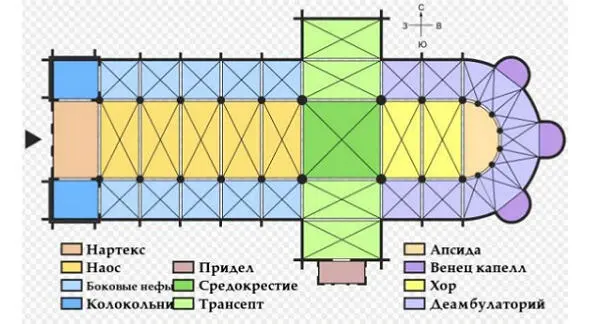
1
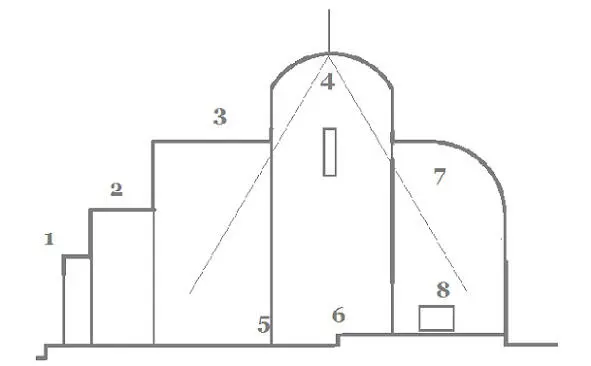
2
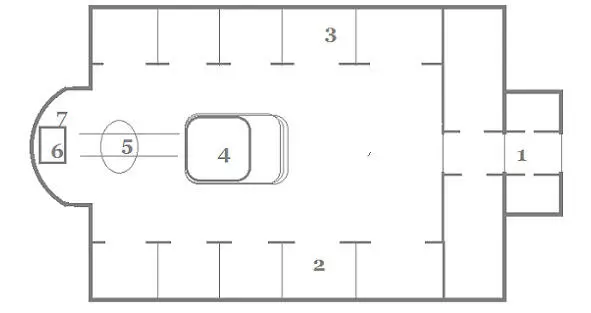
3
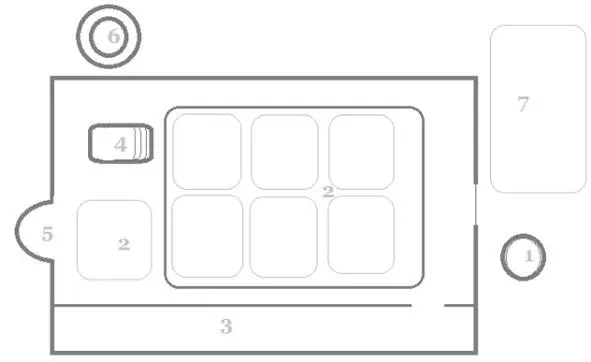
4
1. Catholic church.
(Consistently) Narthex (the porch). Annex in front of the entrance to the temple, checkpoint. It is located on the west side of the main building. The usual place for penitents, «listening» to the few, heretics and pagans.
Naos. The main part of the temple. On the left, closer to the entrance is located, separated by an impenetrable grille, a room for confession reception.
Nave (from the Latin navis – ship) – separated by columns, having the form of elongated rectangles, parts of the interior.
Belltowers. Are located at the entrance to the temple, on either side of the entrance, or above it (in the singular), are usually merged with the building. The main purpose – the convocation of the church service, the celebration of time and special events. In the Western tradition, often used carillon – a mechanical tool that performs on the bells any melody. In modern Catholic churches, bells can be replaced with metal rods, the vibrations of which are amplified by electronics.
The chapel (chapel). Dedicated part of the temple, annex, to accommodate an additional altar with a throne, for worship. Thanks to the side-chapel, in one temple it is possible to perform more than one liturgy (from the Greek «common cause») per day. This rule is the same for the Catholic and Orthodox churches. It can be said that after the main worship, this altar must accumulate a special strength for at least 24 hours.
Saddledness. The intersection of the main nave and the transept (transverse nave). Usually it is crowned by a dome or a tower.
Transsept (from Latin «for» and «fence»). Cross nave, crossing the main longitudinal nave at a right angle, outside the main building forming protuberances – apses.
Apse. In Western European architecture, a semicircular ledge, or a similar in form internal part of the temple, which contains an altar complex.
Crown of chapels. A number of chapels surrounding the apse, radiating from the rays and separated from the choir bypass (de-ambulant).
Chorus (from other Greek group dance). The space before the main throne, where the chorus of singers is placed. Now it includes the Presbytery (Latin Presbyterium – a place for the elect), where only priests could previously go. In some Catholic churches, and now the place of the choir is fenced off by a low balustrade – or is provided for a free tour to all visitors. There may also be a wind organ, a priest-musician, a pulpit, a table and chairs for the preacher.
Deambulary (from the Latin ambio – walking around all around). Semicircular bypass gallery around the altar part of the temple. Allows parishioners to bypass the presbytery to pass to the chapels, respectively, small altars or sacred relics, and also (through the patterned lattice) to survey the shrines that are in the main altar part of the cathedral.
2. Symbolic significance of the architecture of the Orthodox church:
1) The porch. The face of the earth’s being.
2) The stages of the ascent from the earthly to the heavenly.
3) The heavenly realm of earthly existence
4) Visible Sky
5) The main part of the temple
6) Amvon – the region of representation (meeting) of each other to Heaven and Earth
7) The dome above the altar is a symbolic and real Kingdom of Heaven
8) The throne is the throne of the Heavenly King
The internal structure of the Orthodox church is detailed in the section «Russian dynasties», for the best adjustment for this era.
Protestant churches (temples), despite their influence (the United States, England, in all around the world 800 million people), usually do not differ richly decorated. There is no icon-worship, veneration of the relics of the saints: accordingly, there are no icons in the building, or arches with relics. Attitude to the saints, at the same time, respectful. The building of the church can be any leased public building. In the altar there is a table stretched across the hall, with books of the Old and New Testaments, and lamps. Here, with the sermons of the Padres (the Father), the liturgy, communion and baptism are held. The two sacraments are the only ones recognized by this denomination. Much attention is paid here to solving the worldly problems of parishioners, unraveling family conflicts, quarrels of neighbors, etc. (faith without deeds is dead). Protestants (from Latin «publicly proving») are usually not in some kind of confrontation with the Jewish religion, such as the Orthodox and Catholics, see the state of Israel as an important field of God’s activities until the second coming of Jesus Christ.
Читать дальшеИнтервал:
Закладка:
